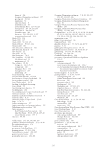Lake Eyre Basin Rivers 28 typically these smaller rivers have simple channel systems, but whether the rainfall data can capture the spatial variability of rainfall patterns. For instance, is the rainfall station network capable of accurately measuring rainfall from isolated thunderstorms (Fig. 2.4) in comparison to widespread rainfall from fronts or larger tropical weather systems? The Lake Eyre Basin presents considerable, but not insurmountable, challenges to hydrological modelling. Despite the lack of extensive monitoring infrastructure, we can make targeted use of satellite data to improve our capacity to model the flow regimes of these rivers with improved accuracy and predictive power. For instance, rigorous mapping of flood patterns across a range of flood volumes, using existing satellite systems, can be combined with the new generation of digital elevation data (e.g. Karim et al. 2012 Mohammadi et al. 2017). This approach would allow the gathering of important information on flow paths that occur between the gauging stations. We can also add value to the increased government and private industry investment in flow-monitoring stations of the past few years. A commitment to gathering discharge (i.e. river flow) data at these newly monitored locations would greatly contribute to the capacity of hydrological models to manage these rivers by allowing the quantitative estimation of flow into different parts of the river systems. A combination of a long-term commitment to data gathering and targeted research will greatly increase our capacity to confidently analyse or model the effects of changing flow regimes on the magnificent arid-zone rivers of the Lake Eyre Basin and their dependent ecosystems and ecosystem services. While we move towards steadily improving our hydrological understanding of the system, we need to be mindful of current limitations when assessing the effects of water resource use and floodplain infrastructure developments. Our capacity to monitor or model changes to the smaller volume flow events is prone to considerable uncertainty and hence our confidence in analysing the effect of flow regime changes on particular assets is presently poor. References Cendón DL, Larsen JR, Jones BG, Nanson GC, Rickleman D, Hankin SI, Pueyo JJ, Maroulis J (2010) Freshwater recharge into a shallow saline groundwater system, Cooper Creek floodplain, Queensland, Australia. Journal of Hydrology 392, 150–163. doi:10.1016/j.jhydrol.2010.08.003 Costelloe JF, Grayson RB, Mcmahon TA (2005) Modelling streamflow for use in ecological studies in a large, arid zone river, central Australia. Hydrological Processes 19, 1165–1183. doi:10.1002/ hyp.5558 Karim F, Kinsey-Henderson A, Wallace J, Arthington AH, Pearson R (2012) Modelling wetland connectivity during overbank flooding in a tropical floodplain in north Queensland, Australia. Hydrological Processes 26, 2710–2723. doi:10.1002/hyp.8364 Kennard MJ, Pusey BJ, Olden JD, Mackay SJ, Stein JL, Marsh N (2010) Classification of natural flow regimes in Australia to support environmental flow management. Freshwater Biology 55, 171–193. doi:10.1111/j.1365-2427.2009.02307.x Kingsford RT (2000) Ecological impact of dams, water diversions and river management on floodplain wetlands in Australia. Austral Ecology 25, 109–127. doi:10.1046/j.1442-9993.2000.01036.x Kingsford RT, Curtin AL, Porter JL (1999) Water flows on Cooper Creek in arid Australia determine ‘boom’ and ‘bust’ periods for waterbirds. Biological Conservation 88, 231–248. doi:10.1016/S0006-3207(98)00098-6
Downloaded from CSIRO with access from at 216.73.216.176 on Nov 27, 2025, 12:39 AM. (c) CSIRO Publishing

















































































































































































































































































